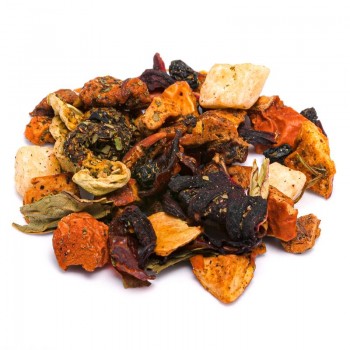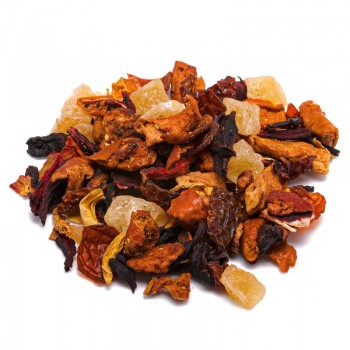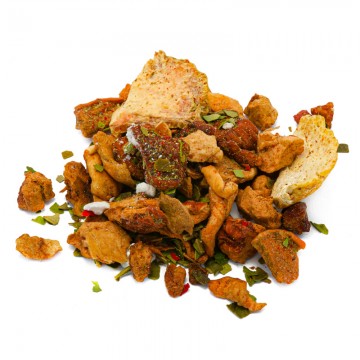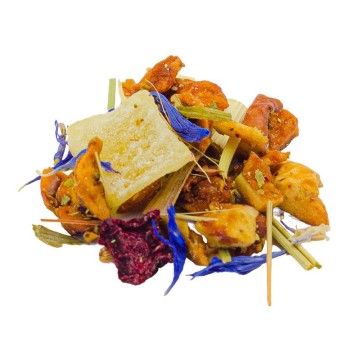The infusion with a velvety flavor gives the palate unique floral and fruity suggestions. An intense aroma, which releases from the pomegranate flowers and hibiscus, is sweetened by the apple and the notes of mallow and cornflower flowers. Elderberries, apple and rose hips provide a sweet and delicious flavour.
Pomegranate and blueberry infusion: properties and benefits
The beneficial properties of the infusion are linked to powerful antioxidant agents contained in the ingredients. The properties of pomegranate, blueberry and hibiscus provide vitamin C and other plant compounds, useful for containing the aging process of tissues. The beneficial action of pomegranate is known on our body and on the skin, thanks to the contribution of substances such as vitamins C and E, as well as antioxidants. For the well-being of the skin, blueberry and pomegranate work in combination with hibiscus and dog rose. By providing vitamin C, they help keep the skin elastic, stimulating the production of collagen and elastin.
Antioxidants help fight free radicals, responsible for signs of aging such as fine wrinkles and sun spots. The long-term effects can be beneficial on skin tightening, to soothe the signs of aging and reduce the effects of cold and sun on the skin. When blueberry, hibiscus and pomegranate (rich in potassium) are combined, the infusion becomes a source of beauty, toning the skin. Drinking this infusion in the evening can help you recover vitamins, minerals and antioxidants useful for skin beauty after the stress of the day. Free radicals can cause damage through poor nutrition, smog, smoking, etc.
The infusion helps to regenerate tissues and thanks to the anthocyanins and flavonoids contained, with richness in tannins and polyphenols which maintain the elasticity of veins and capillaries. Blueberry is combined with pomegranate to enhance the wellbeing virtues on our body. Historically it has been used as a remedy to stimulate microcirculation, counteract venous dilation caused by an excess of free radicals (visible for example in rosacea). Furthermore, the purifying effect of the elements in the mixture helps against water retention even for puffy faces and bags under the eyes. By taking this infusion it is possible to obtain detox effects, given that the anthocyanins contained in the blueberry "hook" to the toxins circulating in the blood to eliminate them, avoiding further cellular damage. Among other virtues, blueberries are rich in antioxidants useful for the well-being of the urinary tract and elderberries promote diuresis. For this reason, the infusion promotes the elimination of toxins and the natural metabolic process.
A purifying capacity that is also useful for the skin, which is brighter and less thick. Furthermore, the digestive properties of this infusion are also known. Several studies have focused on the soothing action of pomegranate for the protection of the stomach and intestines. The digestive system is positively affected by the contribution of pomegranate polyphenols, which can strengthen the barrier of the gastric mucosa, reduce acidity and gastrointestinal discomfort. The contribution of apple and blueberry in the mixture also helps the pomegranate and elderberries to have soothing effects, reducing irritation due to digestion. A gift that also becomes refreshing for the gums and oral cavity, thanks to the infusion of pomegranate flowers.
Origins and history of cultivation
The history of the pomegranate derives from the territory that goes from present-day Iran to the Himalayas, in northern India. From there it spread to different countries: both wild and cultivated, in ancient times the fruits were harvested throughout the Mediterranean, Asia and Persia from 4,000 years ago. The pomegranate is mentioned in Egyptian mythology and the Bible, transported by desert caravans and along the Silk Road. Prized for its juice, it has been called various things. The Latin name of the plant Punica granatum derives from Punicus or Punic, that is, from Northern Africa from which it was believed to originate. In Ayurvedic medicine, pomegranate flowers were historically used to treat cardiovascular diseases and diabetes.
Spanish colonists brought the pomegranate to North America in the 16th century, and today pomegranates are cultivated in many countries of the world: India, Malaysia, arid areas of Asia (China , Afghanistan, Pakistan, Bangladesh, Iran, Iraq, Burma), as well as tropical Africa, Saudi Arabia and Egypt. Blueberries are typical fruits of the undergrowth, and their originis large, these plants growing in territories close to the northern and circumpolar ends of the planet in North America, Europe and Asia.
In Europe they were known in ancient times only in mountainous and northern areas. On the American continent, other varieties were widespread, collected by Native Americans in the forests for food and medicinal use. In the Middle Ages they became part of food and medical culture, as their astringent, tonic and purifying properties for the body were discovered. They are distinguished according to the variety into black, red and blue blueberries and can come from different crops. Species native to Canada and the United States are now also cultivated in the southern hemisphere in Australia, New Zealand and South America (such as the Andean blueberry).
thanks to the infusion of pomegranate flowers.
Fruits and flowers
The components of the infusion are various, including fruits and flowers of different origins in the mixture. The Punica granatum L. tree bears pomegranate fruit and grows mainly in temperate climates. The pomegranate (also called pomegranate) is a fleshy berry, which shows a thick skin, reaching maturity with a yellow-green fruit appearance. Pomegranate flowers develop in flowering varieties, and normally develop into vase-shaped hermaphroditic flowers and bell-shaped male flowers. Inside the fruit there are many fleshy and juicy seeds, which represent the most appetizing edible part. Differences between varieties determine the acidity of the fruits, which are considered sour, sweet or sweet and sour. The blueberry plant is divided into over 100 species, differing in the characteristics of the stem and the color of the fruits. It is a plant belonging to the Ericaceae family, which for blackberries is usually Vaccinium myrtillus while for cranberries it can derive from the subgenus Vaccinium Oxycoccus. The European Sambucus nigra plant belongs to the Sambucus genus in the Adoxaceae family. It is a shrub widespread in Europe and western Asia, which grows in humid places such as swamps and marshes. The cream-colored flowers become small purplish-black berries. The Rose plant is a perennial of the Rosaceae family, of which there are over three hundred species and thousands of cultivars. It can appear in the form of erect shrubs or climbing roses, and show thorns or not.
The flowers vary according to the varieties, with different sizes and shapes, also changing color from white to yellow and very dark red. Most rose species are native to Asia. The apple tree plant, Malus domestica, belongs to the Rosaceae family. It is a tree native to Asia, now widespread throughout the planet. The fruits vary in colour, size and consistency of the pulp - depending on the many varieties, from yellow apples to green and dark red ones. The hibiscus plant is Hibiscus sabdariffa, of the Malvaceae family. It grows in tropical and subtropical regions around the world. The calyx and flowers are used as flavourings, colorants and for the preparation of hibiscus tea. The cornflower is the flower of the annual plant Centaurea cyanus, of the Asteraceae family. It is a plant native to Europe, which often grew in cereal fields. Known scientifically as Malva sylvestris, it is a species of the Malvaceae family. It develops low-growing, easily on open and abandoned fields. The flowers can have lilac, white and pink colors, up to shades of lavender and blue.
Nutritional values of pomegranate and blueberry infusion
The active ingredients of the mixture are mineral salts (including potassium, magnesium, iron, phosphorus), and vitamins A, C, E. Antioxidants, polyphenols and anthocyanins are present. How to use the ingredients in the infusion The infusion is obtained by placing approximately 3-5 grams of the pomegranate and blueberry mixture in a cup (250 ml), with water at a temperature of approximately 100 °C. Leave to infuse for 10 to 12 minutes before drinking. Add honey or sugar, if desired.
Pomegranate and blueberry infusion: side effects and contraindications
To avoid unwanted effects, it is necessary to respect the recommended doses and not exceed the intake of the infusion for too long periods. Excessive intake could cause constipation, nausea, headaches, digestive disorders. Caution advised for pregnant or breastfeeding women.




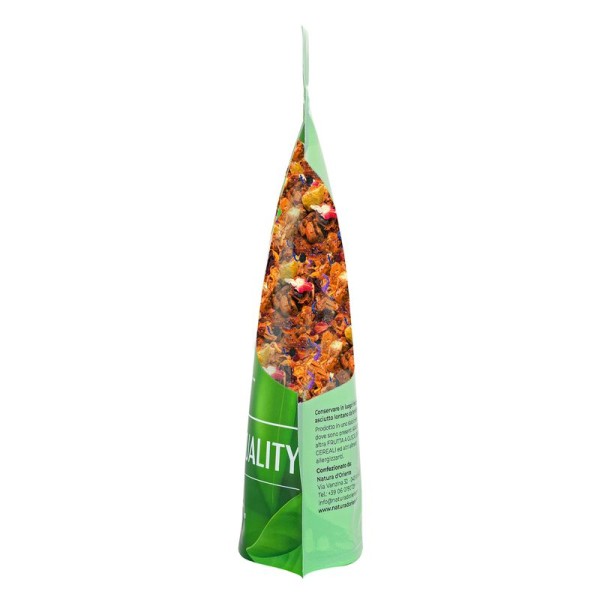






 No reward points for this product.
No reward points for this product.

